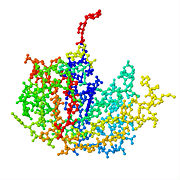From Proteopedia
proteopedia linkproteopedia link
| This Sandbox is Reserved from Feb 02, 2011, through Jul 31, 2011 for use by the Biochemistry II class at the Butler University at Indianapolis, IN USA taught by R. Jeremy Johnson. This reservation includes Sandbox Reserved 191 through Sandbox Reserved 200.
|
To get started:
- Click the edit this page tab at the top. Save the page after each step, then edit it again.
- Click the 3D button (when editing, above the wikitext box) to insert a 3D applet Jmol scene window.
- show the Scene authoring tools, create a molecular scene, and save it. Copy the green link into the page.
- Add a description of your scene. Use the buttons above the wikitext box for bold, italics, links, headlines, etc.
More help: Help:Editing
|
Introduction
Ribonuclease B (RNase B) is a form of the enzyme RNase A that has an added glycoprotein with N-linked carbohydrates at , which means that the carbohydrate is attached at the of the Aspargine-34 side chain. This added sugar chain can aid in the folding of the protein as well as in cell to cell signaling[1]. Glycoproteins also play an important role in tumor formation because it has been found that N-linked glycans recognized by the CD337 receptor on "natural killer cells" are mutated in tumor cells, stopping their death[2]. Other than the attachment of the polysaccharide, RNase B is structurally the same as RNase A, but the attachment allows for additional catalytic activity. This small change allows RNase B to hydrolyze double-stranded RNA at ionic strengths where RNase A has no activity, showing that small changes in the active sites of very similar molecules can lead to new roles and activities [3].
Structure and Biology of RNase B
Crystallization of RNase A and RNase B has shown that these two enzymes are identical in their
primary structure and amino acid makeup; however, RNase B has a single glycosylation at the site that differentiates RNase B from RNase A. RNase B has from five to nine mannose residues attached which can create a variance within RNase B molecules. This glycosylation increases the kinetic stability of the RNase B by 3 kJ/mol
[4]. This addition to RNase B, however, does not significantly change the protein conformation from RNase A
[5].
Slight differences include changes in crystal packing, as the RNase B crystals have two slightly asymmetrical units. The crystals are (shown above) with two separate molecules, and , which are linked by a salt bridge at Asp-121 and Arg-85. This linkage determines the orientation of the two molecules in relation to one another. Not only does a salt bridge link this dimer-type molecule, but other ions also interact via cross-linkage to stabilize the structure [3].
The crystallization of RNase B, in complex with sequence DNA, provided the structure of the active site when bound to nucleic acids. The active site, composed of and found in both molecules I and II of RNase B, is very similar to the active site of RNase A. A difference between RNase A and RNase B is , which are very flexible and can open up or close off the active site. Molecules I and II are slightly asymmetrical, and the most noticeable difference between the two is the position of the . This residue, which is present in both molecules, is much closer to the active site in molecule II. This is important because ions bind to Lys-66, like the DNA, making them accessible to the active site. While the crystalline packing of molecules I and II differ slightly, their active sites bind substrate in the same manner. Even though the crystallization of the structure has been successful, it has not been an aid to providing the mechanism by which RNase B has the catalytic activity to hydrolyze double stranded RNA.[3].
References
- ↑ Varki A, Cummings RD, Esko JD, Freeze HH, Stanley P, Bertozzi CR, Hart GW, Etzler ME. Essentials of Glycobiology. PMID:20301239
- ↑ http://en.wikipedia.org/wiki/Glycan
- ↑ 3.0 3.1 3.2 Williams RL, Greene SM, McPherson A. The crystal structure of ribonuclease B at 2.5-A resolution. J Biol Chem. 1987 Nov 25;262(33):16020-31. PMID:3680242
- ↑ Imperiali B, O'Connor SE. Effect of N-linked glycosylation on glycopeptide and glycoprotein structure. Curr Opin Chem Biol. 1999 Dec;3(6):643-9. PMID:10600722
- ↑ Joao HC, Scragg IG, Dwek RA. Effects of glycosylation on protein conformation and amide proton exchange rates in RNase B. FEBS Lett. 1992 Aug 3;307(3):343-6. PMID:1322837
Additional Resources

